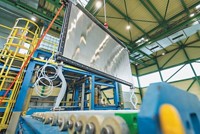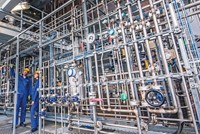Advertisement
Grab your lab coat. Let's get started
Welcome!
Welcome!
Create an account below to get 6 C&EN articles per month, receive newsletters and more - all free.
It seems this is your first time logging in online. Please enter the following information to continue.
As an ACS member you automatically get access to this site. All we need is few more details to create your reading experience.
Not you? Sign in with a different account.
Not you? Sign in with a different account.
ERROR 1
ERROR 1
ERROR 2
ERROR 2
ERROR 2
ERROR 2
ERROR 2
Password and Confirm password must match.
If you have an ACS member number, please enter it here so we can link this account to your membership. (optional)
ERROR 2
ACS values your privacy. By submitting your information, you are gaining access to C&EN and subscribing to our weekly newsletter. We use the information you provide to make your reading experience better, and we will never sell your data to third party members.
Specialty Chemicals
Under pressure, Johnson Matthey seeks profit in hydrogen
The 205-year-old British firm is betting on low-carbon technology to turn its fortunes around
by Alex Scott
April 26, 2023
| A version of this story appeared in
Volume 101, Issue 14

Johnson Matthey had a trickier time in the pandemic than most chemical firms. Faced with setbacks in late 2021 and into 2022, the company ditched its long-term growth plan and sold its pharmaceutical ingredients, glass technology, and battery materials businesses.
Johnson Matthey at a glance
▸ Sales: $5.1 billion
▸ Operating profit: $727 million
▸ Core expertise: Platinum group metal chemistry
▸ Growth businesses: Syngas, CO2 purification, fuel cell and electrolyzer components
▸ R&D spending: $283 million
▸ Company employees: 13,000
▸ R&D employees: 1,600:
Source: Johnson Matthey.
Note: Financial figures are for the fiscal year that ended March 31, 2022.
Exits from these supposedly future-proof sectors forced the company to take hundreds of millions of dollars in write-downs. Its CEO departed amid the turmoil. Reliant on its huge but shrinking automotive catalytic converter business, JM continues to wobble—perhaps most dramatically since its founding in 1817.
JM’s fallback is platinum group metal (PGM) chemistry, in which it has a long-held competence. The field is highly adaptable and—right now—increasingly sought after for catalyzing the production of low-carbon fuels and chemical feedstocks. In-demand technologies include those for making syngas from nonfossil raw materials and chemicals and fuels from hydrogen and waste carbon dioxide.
The company also makes components for fuel cells that turn hydrogen into electricity and for electrolyzers that generate hydrogen from water and electricity. JM is now throwing the kitchen sink at these businesses. The firm is a technology leader in some of them, but they are still small for JM and are being pursued by many other contenders. Meanwhile, JM faces a major challenge in replacing its catalytic converter business.
The job of commercializing these PGM-based technologies falls in large part to JM’s chief technology officer, Maurits van Tol, an industry veteran of 25-plus years who joined the firm in 2019 from the petrochemical maker Borealis.
PGM chemistry has many applications. “The trick is to select what you should be doing,” van Tol says. Two years ago, JM wasn’t sure which direction to take, but it is now: “That is catalysis and the application of catalysis in the cleantech space,” he says.
At the heart of the cleantech space is hydrogen, and JM claims to be the world’s number one licensor of catalytic processes for producing hydrogen from fossil fuels. The firm has adapted this technology for the cleantech market and has begun offering its Low Carbon Hydrogen (LCH) process, which facilitates the reforming of natural gas into so-called blue hydrogen while capturing by-product carbon dioxide. The technology has been selected for HyNet North West, the UK’s first major project to produce hydrogen from natural gas and capture by-product CO2.
“We have developed a technology that very cleverly integrates a gas-heated reformer and an autothermal reformer,” van Tol says of LCH. The result will be a facility that is just 40% the size of projects developed by other companies—and thus much cheaper to build. It will also consume about 10% less energy than facilities built with competing technologies while yielding highly pure hydrogen, according to JM. By-product CO2 is also highly pure with LCH, van Tol adds.
Scaling up the technology is not an issue, as a form of it has been deployed for hydrogen and methanol production “for a very long time,” van Tol says. “People ask for 160,000-ton-per-year hydrogen plants, and that’s comfortably what we can offer.”
PGM technology for making syngas, a combination of hydrogen and carbon monoxide, is an established business for JM. It is also one that the company is adapting to suit the market’s need for low-carbon fuels and feedstocks. During the pandemic, JM developed HyCogen, a process that reacts captured CO2 with hydrogen to make syngas that can be converted into fuels or chemicals.
JM is also offering syngas processes that can be used with other feedstocks. For example, it partnered with BP to develop FT CANS, a technology that can convert a range of feedstocks, including municipal waste, into hydrocarbons. These hydrocarbons can then be upgraded into jet fuel or other products, van Tol says. In May 2022, Aramco and Repsol selected FT CANS and HyCogen for a synthetic fuels plant planned for Bilbao, Spain. JM has also codeveloped a PGM catalyst with Virent that converts biomass into sugars and then into jet fuel and aromatic compounds such as p-xylene.
Perhaps JM’s biggest cleantech opportunity is in its PGM-based catalyst-coated membrane (CCM) business. CCMs are the core of electrolyzers that turn water into oxygen and hydrogen, as well as of fuel cells that generate electricity from hydrogen—essentially the reverse process.
“We now see extremely accelerated growth in fuel cells and electrolyzers,” van Tol says. The PGM chemistry in CCMs for proton-exchange membrane (PEM) electrolyzers is not so different from that developed by JM for fuel cells, he notes. “We have this extremely long history in fuel cells that we can now use to help bring this nascent, almost artisanal electrolyzer industry to full industrial scale.”
JM’s focus in electrolyzers is on producing components, including CCMs, for PEM systems. They are the most widely used electrolyzers, but the firm is keeping its options open. To this end, JM paid about $20 million in May 2022 to acquire a minority stake in Enapter, an Italian firm developing anion-exchange membrane electrolyzers. Enapter claims these electrolyzers have the potential to be cheaper than the incumbent PEM products. The two companies are jointly developing advanced components and a recycling process. JM is also supplying Enapter with specialized catalysts.
JM may be concentrating on the cleantech sector but is not ignoring its catalytic converter business. “There are still an awful lot of internal combustion engines being built, whether it is for cars, for trucks, for buses, or for stationary sources,” van Tol says. R&D in this field is far from over, he adds. A substantial number of the firm’s 1,600 R&D employees are working on catalytic converters that use smaller amounts of PGMs while meeting ever-tighter air emission standards.
JM remains financially reliant on this sunsetting business. In the firm’s fiscal year ending March 31, 2022, its Clean Air division—predominantly a maker of automotive catalytic converters—represented 62% of JM’s $5.1 billion in sales and 54% of its $727 million in operating income.
The PGM Services division is, among other things, a recycler of catalytic converters. In the same fiscal year, the division generated about 15% of JM’s sales and 55% of its operating income. Meanwhile, Catalyst Technologies, which includes syngas activities, posted sales of $597 million but a relatively small operating profit of $66 million, and the nascent Hydrogen Technologies division lost about $43 million.
Liam Condon left his role as head of Bayer Crop Science to become JM’s CEO in March 2022. On his arrival, he set out a series of performance goals that are to be reached by the end of March 2024. Among them are winning at least 10 large-scale projects, including ones in cleantech; completing the construction of a CCM plant in the UK; and expanding the firm’s capacity to produce fuel cell and formaldehyde catalysts.
Despite Condon’s enthusiasm, JM’s pivot has not been well received by shareholders. The company’s share price is about 40% lower than it was before it changed strategy.
In addition, over a year after Condon’s appointment, a surge in orders for JM’s cleantech offerings has not materialized. JM reported a 25% decline in pretax profits for the 6 months ending in September 2022. Condon’s reaction was to begin a 15% cull of management staff as part of a plan to reduce annual costs by almost $200 million.
Although JM has near-term woes, it also has grounds for optimism, Charles Bentley, a stock analyst at the investment firm Jefferies, told clients in an April 2 research note. Bentley flags an increase in JM’s pipeline of catalyst technology project opportunities to 100 from 70, three recent contract wins, and a major collaboration with the US fuel cell and hydrogen producer Plug Power.
Condon may be disappointed that major cleantech contracts are not pouring in, but the shift to a hydrogen-intensive economy is starting to gather momentum. JM should know soon enough whether it can put fossil fuels behind it and transform into a producer of catalysts for a low-carbon future.





Join the conversation
Contact the reporter
Submit a Letter to the Editor for publication
Engage with us on Twitter